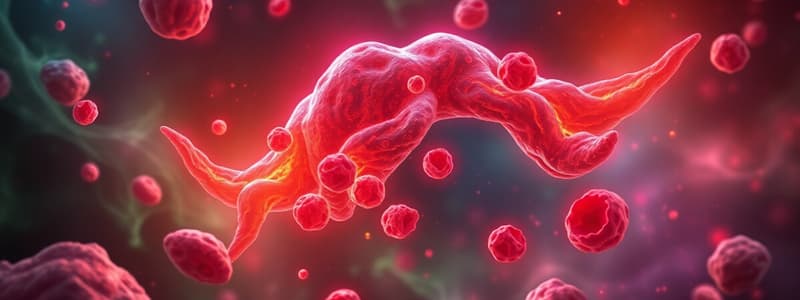Podcast
Questions and Answers
What primarily causes megaloblastic anaemia?
What primarily causes megaloblastic anaemia?
- Excessive hydration
- Nuclear maturation defect due to ineffective erythropoiesis (correct)
- Iron deficiency
- Genetic mutations
Which vitamin deficiencies are the most common causes of megaloblastic anaemia?
Which vitamin deficiencies are the most common causes of megaloblastic anaemia?
- Cobalamin and Folate (correct)
- Vitamin C and Vitamin D
- Iron and Zinc
- Vitamin A and Vitamin K
What is the primary reason for cobalamin deficiency?
What is the primary reason for cobalamin deficiency?
- Poor digestion of fats
- Insufficient dietary intake
- Increased absorption rate
- Inadequate intrinsic factor (correct)
Which protein is important for the absorption of B12 in the ileum?
Which protein is important for the absorption of B12 in the ileum?
What is the optimal pH required for the proton-coupled folate transporter (PCFT) for folate absorption?
What is the optimal pH required for the proton-coupled folate transporter (PCFT) for folate absorption?
Where in the body is folate primarily absorbed?
Where in the body is folate primarily absorbed?
What is a common cause of folate deficiency?
What is a common cause of folate deficiency?
Which form of folate is released into circulation after reduction and methylation in enterocytes?
Which form of folate is released into circulation after reduction and methylation in enterocytes?
What role does trypsin play in B12 absorption?
What role does trypsin play in B12 absorption?
What is a significant feature of megaloblastic anaemia regarding the cell cycle?
What is a significant feature of megaloblastic anaemia regarding the cell cycle?
Flashcards
Megaloblastic Anemia
Megaloblastic Anemia
A type of anemia characterized by the presence of abnormally large red blood cells (megaloblasts) due to impaired DNA synthesis, primarily caused by vitamin B12 (cobalamin) or folate deficiency.
Ineffective Erythropoiesis
Ineffective Erythropoiesis
The process of red blood cell formation is inefficient, leading to a decreased number of functional red blood cells.
Cobalamin Deficiency: Cause
Cobalamin Deficiency: Cause
A lack of intrinsic factor (IF) is the most common cause of vitamin B12 deficiency.
Folate Deficiency: Cause
Folate Deficiency: Cause
Signup and view all the flashcards
B12 Release
B12 Release
Signup and view all the flashcards
B12 Binding to Intrinsic Factor
B12 Binding to Intrinsic Factor
Signup and view all the flashcards
B12 Absorption
B12 Absorption
Signup and view all the flashcards
Folate Processing
Folate Processing
Signup and view all the flashcards
Folate Absorption
Folate Absorption
Signup and view all the flashcards
Folate Transport Proteins
Folate Transport Proteins
Signup and view all the flashcards
Study Notes
Megaloblastic Anaemia
- Megaloblastic anaemia results from a nuclear maturation defect, primarily due to ineffective erythropoiesis.
- This leads to cell cycle arrest.
- Approximately 95% of megaloblastic anaemias are caused by cobalamin or folate deficiency.
Learning Objectives
- Define megaloblastic anaemia and describe its features.
- Recognize the link between cobalamin and folate deficiencies and megaloblastic change.
- Understand the role of cobalamin and folate in the cell cycle.
- Identify the common causes of cobalamin and folate deficiencies.
Cobalamin (B12) Absorption
- B12 is released from food by pepsin and stomach acid.
- It binds to haptocorrin.
- In the duodenum, pancreatic trypsin releases B12 from haptocorrin.
- Free B12 binds to intrinsic factor and is transported to the distal/terminal ileum.
- Absorbed by the enterocyte via Cubilin.
- In the circulation, 80% binds haptocorrin (TC2), and 20% transcobalamin (TC1).
- The transcobalamin-B12 complex is absorbed by target cells via the megalin/transcobalamin receptor.
- Lysosomal degradation releases B12 into the cytoplasm, while the megalin/transcobalamin receptor returns to the membrane.
Folate Absorption
- Folates are primarily absorbed in the duodenum and jejunum.
- They need an acidic microenvironment.
- Dietary polyglutamated folates are converted to monoglutamate by glutamate carboxypeptidase II.
- Requires proton-coupled folate transporter (PCFT) (optimal pH 5.0-5.5) and reduced folate carrier (RCF) (optimal pH 7.4).
- Once inside enterocytes, folates are reduced and methylated to form 5-methyltetrahydrofolate (5MTHF).
- 5MTHF is removed to the circulation by MRP3 on the basolateral membrane.
Cobalamin vs. Folate Deficiency
-
Cobalamin-related deficiency:*
-
Dietary deficiency
-
Reduced release from food
-
Inadequate intrinsic factor
-
Impaired release from haptocorrin
-
Malabsorption of ileum
-
Drug-induced malabsorption
-
Inactivation by nitrous oxide
-
Inherited metabolic defect
-
Folate-related deficiency:*
-
Dietary deficiency
-
Jejunal abnormalities
-
Drug-induced malabsorption
-
Increased requirement
-
Increased loss
-
Acquired defects of folate metabolism
-
Inherited metabolic abnormalities
Megaloblastic Morphology
- Characterized by nuclear-cytoplasmic asynchrony—the nucleus of the cell is not mature at the same rate as the cytoplasm.
- This is a consequence of abnormal DNA synthesis.
Summary
- Cobalamin and folate deficiency cause macrocytic anaemia.
- The term "megaloblastic" refers to the appearance of bone marrow-derived progenitors.
- Abnormal DNA synthesis is responsible for the morphological findings associated with megaloblastic anaemia.
- Various conditions can lead to cobalamin and/or folate deficiency.
- Cobalamin deficiency can cause irreversible neurological degeneration.
Studying That Suits You
Use AI to generate personalized quizzes and flashcards to suit your learning preferences.




